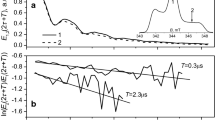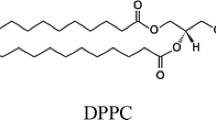Abstract
The stability of lipid bilayers is ultimately linked to the hydrophobic effect and the properties of water of hydration. Magic angle spinning (MAS) nuclear Overhauser enhancement spectroscopy (NOESY) with application of pulsed magnetic field gradients (PFG) was used to study the interaction of water with 1-palmitoyl-2-oleoyl-sn-glycero-3-phosphocholine bilayers in the fluid phase. NOESY cross-relaxation between water and polar groups of lipids, but also with methylene resonances of hydrophobic hydrocarbon chains, has been observed previously. This observation led to speculations that substantial amounts of water may reside in the hydrophobic core of bilayers. Here, the results of a quantitative analysis of cross-relaxation in a lipid 1-palmitoyl-2-oleoyl-sn-glycero-3 phosphocholine (POPC)/water mixture are reported. Coherences were selected via application of pulsed magnetic field gradients. This technique shortens acquisition times of NOESY spectra to 20 min and reduces t 1-spectral noise, enabling detection of weak crosspeaks, like those between water and lipids, with higher precision than with non-gradient NOESY methods. The analysis showed that water molecules interact almost exclusively with sites of the lipid–water interface, including choline, phosphate, glycerol, and carbonyl groups. The lifetime of lipid–water associations is rather short, on the order of 100 ps, at least one order of magnitude shorter than the lifetime of lipid–lipid associations. The distribution of water molecules over the lipid bilayer was measured at identical water content by neutron diffraction. Water molecules penetrate deep into the interfacial region of bilayers but water concentration in the hydrophobic core is below the detection limit of one water molecule per lipid, in excellent agreement with the cross-relaxation data.






Similar content being viewed by others
References
Arndt UW, Willis BTM (1966) Single crystal diffractometry. Cambridge Univerisity Press, Cambridge
Arnold K, Gawrisch K (1993) Effects of fusogenic agents on membrane hydration: a deuterium nuclear magnetic resonance approach. Methods Enzymol 220:143–157
Arnold K, Herrmann A, Pratsch L, Gawrisch K (1985) The dielectric properties of aqueous solutions of poly(ethylene glycol) and their influence on membrane structure. Biochim Biophys Acta 815:515–518
Bacon GE (1975) Neutron diffraction, 3rd edn. Clarendon Press, Oxford
Bacon GE, Lowde RD (1948) Secondary extinction and neutron crystallography. Acta Cryst 1:303–314
Berendsen HJC (1975) In: Franks F (ed) Water: a comprehensive treatise, vol 5. Plenum Press, New York, London, pp 293
Blasie JK, Schoenborn BP, Zaccai G (1975) Direct methods for the analysis of lamellar neutron diffraction from oriented multilayers: a difference Patterson deconvolution approach. Brookhaven symposium in biology, pp III–59
Bloom M, Mouritsen OG (1988) The evolution of membranes. Can J Chem 66:706–712
Borle F, Seelig J (1983) Hydration of Escherichia coli lipids. Deuterium T1 relaxation time studies of phosphatidylglycerol, phosphatidylethanolamine and phosphatidylcholine. Biochim Biophys Acta 735:131–136
Caspar DL, Philips WC (1975) Dynamical effects in small angle neutron diffraction from membranes. Brookhaven Symp Biol, pp VII–107
Cowley AC, Fuller NL, Rand RP, Parsegian VA (1978) Measurement of repulsive forces between charged phospholipid bilayers. Biochemistry 17:3163–3168
Disalvo EA, Siddiqi FA, Tien HT, Benga G (1989) Membrane transport with emphasis on water and non-electrolytes in experimental lipid bilayers and biomembranes water transport in biological membranes, vol 1. CRC Press, Boca Raton
Dura JA, Pierce DJ, Majkrzak CF, Maliszewskyj NC, McGillivray DJ, Losche M, O’Donovan KV, Mihailescu M, Perez-Salas U, Worcester DL, White SH (2006) AND/R: Advanced neutron diffractometer/reflectometer for investigation of thin films and multilayers for the life sciences. Rev Sci Instrum 77
Finer EG, Darke A (1974) Phospholipid hydration studied by deuteron magnetic resonace spectroscopy. Chem Phys Lipids 12:1–16
Forbes J, Husted C, Oldfield E (1988) High-field, high-resolution proton “magic-angle” sample-spinning nuclear magnetic resonance spectroscopic studies of gel and liquid crystalline lipid bilayers and the effects of cholesterol. J Am Chem Soc 110:1059–1065
Franks NP, Lieb WR (1979) Structure of lipid bilayers and the effects of general anesthetics—X-ray and neutron diffraction study. J Mol Biol 133:469–500
Frischleder H, Peinel G (1982) Quantum-chemical and statistical calculations on phospholipids. Chem Phys Lipids 30:121–158
Gaede HC, Gawrisch K (2003) Lateral diffusion rates of lipid, water, and a hydrophobic drug in a multilamellar liposome. Biophys J 85:1734–1740
Gaede HC, Gawrisch K (2004) Multidimensional PFG-MAS-NMR experiments on membranes. Magn Reson Chem 42:115–122
Gawrisch K, Arnold K, Gottwald T, Klose G, Volke F (1978) 2H NMR studies of the phosphate water interaction in dipalmitoylphosphatidylcholine/water systems. Stud Biophys 74:13–14
Gawrisch K, Richter W, Möps A, Balgavy P, Arnold K, Klose G (1985) The influence of water concentration on the structure of egg yolk phospholipid/water dispersions. Stud Biophys 108:5–16
Gawrisch K, Ruston D, Zimmerberg J, Parsegian VA, Rand RP, Fuller N (1992) Membrane dipole potentials, hydration forces, and the ordering of water at membrane surfaces. Biophys J 61:1213–1223
Helfrich W (1978) Steric interaction of fluid membranes in multilayer systems. Z Naturforsch 33a:305–315
Hristova K (1998) Determination of the hydrocarbon core structure of fluid dioleoylphosphocholine (DOPC) bilayers by X-ray diffraction using specific bromination of the double-bonds: Effect of hydration. Biophys J 74:2419–2433
Huster D, Gawrisch K (1999) NOESY NMR crosspeaks between lipid headgroups and hydrocarbon chains: spin diffusion or molecular disorder? J Am Chem Soc 121:1992–1993
Huster D, Jin AJ, Arnold K, Gawrisch K (1997) Water permeability of polyunsaturated lipid membranes measured by 17O NMR. Biophys J 73:855–864
Huster D, Arnold K, Gawrisch K (1999) Investigation of lipid organization in biological membranes by two-dimensional nuclear Overhauser enhancement spectroscopy. J Phys Chem B 103:243–251
Israelachvili J, Wennerström H (1996) Role of hydration and water structure in biological and colloidal interactions. Nature 379:219–225
Klose G, Koenig BW, Meyer HW, Schulze G, Degovics G (1988) Small-angle X-ray scattering and electron microscopy of crude dispersions of swelling lipids and the influence of the morphology on the repeat distance. Chem Phys Lipids 47:225–234
Koenig BW, Strey HH, Gawrisch K (1997) Membrane lateral compressibility determined by NMR and X-ray diffraction: effect of acyl chain polyunsaturation. Biophys J 73:1954–1966
Leikin S, Kornyshev AA (1990) Theory of hydration forces—nonlocal electrostatic interaction of neutral surfaces. J Chem Phys 92:6890–6898
LeNeveu DM, Rand RP, Parsegian VA (1976) Measurement of forces between lecithin bilayers. Nature 259:601–603
Mihailescu M, Gawrisch K (2006) The structure of polyunsaturated lipid bilayers important for rhodopsin function—a neutron diffraction study. Biophys J 90:L4–L6
Nagle JF (1993) Area/lipid of bilayers from NMR. Biophys J 64:1476–1481
Parsegian VA, Rand RP, Fuller NL, Rau DC (1986) Osmotic stress for the direct measurement of intermolecular forces. Methods Enzymol 127:400–416
Price WS, Ide H, Arata Y (1999) Self-diffusion of supercooled water to 238 K using PGSE NMR diffusion measurements. J Phys Chem A 103:448–450
Simon SA, McIntosh TJ, Latorre R (1982) Influence of cholesterol on water penetration into bilayers. Science 216:65–67
Tanford C (1980) The hydrophobic effect: formation of micelles and biological membranes. Wiley, New York
Volke F, Pampel A (1995) Membrane hydration and structure on a subnanometer scale as seen by high-resolution solid-state nuclear magnetic resonance: POPC and POPC/C12 EO4 model membranes. Biophys J 68:1960–1965
Volke F, Eisenblätter S, Galle J, Klose G (1994) Dynamic properties of water at phosphatidylcholine lipid-bilayer surfaces as seen by deuterium and pulsed-field gradient proton NMR. Chem Phys Lipids 70:121–131
White S, Jacobs RE, King GI (1987) Partial specific volumes of lipid and water in mixtures of egg lecithin and water. Biophys J 52:663–665
Wiener MC, White SH (1991a) Fluid bilayer structure determination by the combined use of X-ray and neutron diffraction. I. Fluid bilayer models and the limits of resolution. Biophys J 59:162–173
Wiener MC, White SH (1991b) Fluid bilayer structure determination by the combined use of X-ray and neutron diffraction. II. Composition-space refinement method. Biophys J 59:174–185
Wiener MC, White SH (1992) Structure of a fluid dioleoylphosphatidylcholine bilayer determined by joint refinement of X-ray and neutron diffraction data. III. Complete structure. Biophys J 61:434–447
Wiener MC, King GI, White SH (1991) Structure of a fluid dioleoylphosphatidylcholine bilayer determined by joint refinement of X-ray and neutron diffraction data. I. Scaling of neutron data and the distributions of double bonds and water. Biophys J 60:568–576
Worcester DL, Franks NP (1976) Structural analysis of hydrated egg lecithin and cholesterol bilayers. II. Neutron diffraction. J Mol Biol 100:359–378
Xu ZC, Cafiso DS (1986) Phospholipid packing and conformation in small vesicles revealed by two-dimensional 1H nuclear magnetic resonance cross-relaxation spectroscopy. Biophys J 49:779–783
Yau WM, Gawrisch K (2000) Lateral lipid diffusion dominates NOESY cross-relaxation in membranes. J Am Chem Soc 122:3971–3972
Zaccai G, Büldt G, Seelig A, Seelig J (1979) Neutron diffraction studies on phosphatidylcholine model membranes. II. Chain conformation and segmental disorder. J Mol Biol 134:693–706
Zhou Z, Sayer BG, Hughes DW, Stark RE, Epand RM (1999) Studies of phospholipid hydration by high-resolution magic-angle spinning nuclear magnetic resonance. Biophys J 76:387–399
Acknowledgments
K.G. and H.G. were supported by the intramural program of NIAAA, NIH. The neutron diffraction studies were conducted on the AND/R instrument, constructed by the Cold Neutrons for Biology and Technology (CNBT) partnership, supported by the National Institute of Standards and Technology, the Regents of the University of California, and by a grant RR14812 from the National Institute for Research Resources awarded to the University of California at Irvine.
Author information
Authors and Affiliations
Corresponding author
Additional information
Dedicated to Prof. K. Arnold on the occasion of his 65th birthday.
Rights and permissions
About this article
Cite this article
Gawrisch, K., Gaede, H.C., Mihailescu, M. et al. Hydration of POPC bilayers studied by 1H-PFG-MAS-NOESY and neutron diffraction. Eur Biophys J 36, 281–291 (2007). https://doi.org/10.1007/s00249-007-0142-6
Received:
Revised:
Accepted:
Published:
Issue Date:
DOI: https://doi.org/10.1007/s00249-007-0142-6




